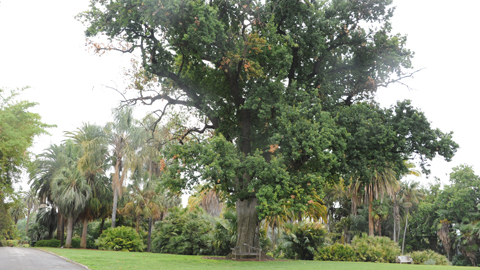The Huntington’s blog takes you behind the scenes for a scholarly view of the collections.
MR. HUNTINGTON'S GARDEN | Looming Losses
Posted on Tue., June 21, 2011
Another post in a series about Mr. Huntington's Garden by the botanical director of The Huntington.
Perhaps the most significant plants we tuck into the landscape are trees, which give structure and bring a sense of permanence. As gardeners, we know that nothing is really permanent, and just about the time you count on a beautiful tree as the soul of the landscape, it is doomed. And we are being reminded of that very simple truth these days.
Last Monday, David MacLaren (the curator of Asian gardens) and I were looking at the site for the new teahouse and saw that one of the deodars at the entry to the new tea garden had changed color—all of a sudden. The needles are all brown, and we know the tree will need to be removed during garden construction this fall. And down by the Desert Garden, we have been nursing along a chorisia, right by the road. We planned to remove it in the next fiscal year, but closer inspection of the tree base this week changed the schedule. The wood inside roots on one side of the tree had suffered some decay, and we could no longer assume the tree was sound. That judgment was made late last week, so the tree was removed this morning.
Looking around the landscape, we see other trees in trouble. One of our favorite specimens, the large English oak on the lawn near the Palm Garden, is beginning to show die-back. In early July we will bring in an outside company to remove limbs that did not produce new foliage this spring, but on general inspection this wonderful specimen is beginning to decline. My assumption is that we will need to remove it sometime in the next two to three years, which is truly unfortunate. It has been a sentinel at the top of the hill as long as any of us can remember. Of course, we will also inspect the soil to see if there is any way to reverse the decline, but experience tells us that chances are not great. At least we will take the opportunity to gather a few acorns this fall to generate another round of progeny.
So why are these trees dying? The answers, in each of the three cases, are in the soil. One serious reason we lose trees is the pervasiveness of oak root fungus, Armillaria mellea—also called shoestring disease. Another is simple root rot, which is caused by a host of fungi, most prominently Phytophthora. But there are many other potential causes for decline, from drainage considerations to soil pH and nutrition issues.
And what happens when we lose a great tree? Of course that depends on the location. If the understory is a complex shade garden, then the entire area needs relandscaping. In the case of the three trees I mention here, the ground plane is lawn, so the main concern becomes what to do for structure and shade in the landscape. Sometimes, when a tree is lost, there is a new opportunity for a different solution. But in other situations, there is nothing quite as wonderful as planting a replacement. That becomes, of course, an investment for visitors many decades in the future.
Jim Folsom is the Telleen/Jorgensen Director of the Botanical Gardens at The Huntington.
